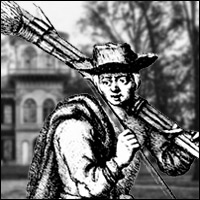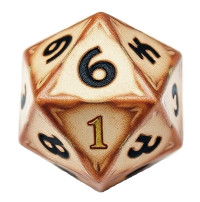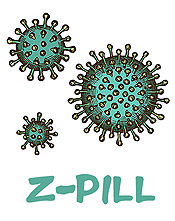“There was not a Christian man, as they term it, to serve him; nothing but negroes. All this was increased by a miserable, doubly miserable wife; but so miserable that I will not relate it here. All his children have been compelled on her account to leave their father’s house.”
-Jasper Danckhaerts, Sunday, December 3, 1679, describing The Plantation of the Greatest Dutch Lord in Maryland, Augustine Hermans, as supervised by his “second wife.”
“Ephraim Hermans is the oldest child of Augustine Hermans, there being two brothers and three sisters, one of whom lives now at Amsterdam. They are all of a Dutch mother, after whose death their father married an English woman, who is the most artful and despicable creature that can be found. He is a very godless person, and his wife, by her wickedness, has compelled all these children to leave their father's house and live elsewhere.”
-Jasper Danckaerts, Tuesday, December 26th, 1679
The following primary sources discuss disagreeable wives in The English Plantations: Peter Kalm, 1748, Gottlieb Mitterberger, 1754, Mary Rawlinson, her bitch self from 1675, Samuel Wiseman from 1676, Thomas Hellier from 1678, Meshach Browning from the 1790s and more. These women taken together, form the picture of the wicked stepmother of legend, the stepmother who beat Herman Melville’s character Ishmael every day. This wicked stepmother is magnified when she becomes the slave mistress in the slave narratives of Moses Roper and Solomon Northup in the early to mid-1800s.
Not being in a position to compare the institution of stepmotherhood in The Plantations and the Home Country, if we are to take these first hand authors at their word, that the second wife is more wicked in the New world than in the Old, and that even the first wife is more wicked in the Plantations than in the Fatherland or Motherland, do we have any means of correlation?
It has long been understood that high maternal mortality in childbirth prior to the 20th century contributed to the practice of second wifing and the cruel institution of the stepmother. This was a constant in all societies, yet in neighboring Amerindian societies there was zero tradition of child abuse by mothers. Iikewise, child abuse was far more severe in The Plantations than the Home Country as attested to by numerous witnesses.
The first correlation is slavery, that women, in any positions of power they are elevated to, have a clear, distinct and general tendency to be more cruel than men. For instance European queens waged war at a 30% higher rate than European kings. All slave narratives by men and women name the slave mistress as more cruel than the slave master. Many accounts of aboriginal cruelty to enemy captives point to the enemy women being far more cruel than enemy men. This is a simple power dynamic, as women, without proxy power, are too physically weak to impose their will on men and have not developed the self-control necessary to prevent their cruelty to those who fall into their power. Numerous authoritative studies [see Molynuex’s Bomb in the Brain series] demonstrate that women engage in child abuse more than men, that lesbians beat their female partners more than men, and that, furthermore, nursing home staffers who are female engage in higher levels of patient abuse than those who are male. My personal experience in the workplace, after 38 years, was that most male managers practiced minimal threat supervision and that most female managers practiced maximum threat supervision.
Slavery, certainly exasperated the situation in The Plantations, as men were absent as often as not, leaving slaver supervision often in the hands of women.
Paternal infidelity was another exasperating factor, as a slave master was free to have sex with any and all of his slaves, with no such man ever prosecuted for rape in 250-odd years, even to the point where his offspring would be his slave and that the woman he impregnated would be bound t him for increased years as the act was her sin and not his. In this situation, we develop tropes such as “to beat you like a red-headed step-child” which my grandmother Kern and great grandmother Quade used, from long time Maryland slave families of German and Irish Catholics, largely owned by English. The “red-headed step child” was originally the bastard of the slave master and his Irish servant girl, who received especially cruel treatment from her relatively homely English mistress and stepmother.
Could there be another source of cruelty other than the mental warping of slavery, the powerless-breeds-cruelty towards the weak and the simple jealousy of a jilted wife?
Yes, also attested to in Alsop’s 1665 verse, prose and letters is the fact that women were so scarce in Maryland that slave girls, even those not very good to look at, could expect to be purchased as a wife. One truism of life throughout the ages is that the weak, when elevated, tend to be cruel. Another is that when the socially low gain power, they are cruelest of the all. By taking a slave girl and making her mistress of a 300 acres farm served by human property who she can beat, molest and even kill at will with no legal penalty, we have seen the elevation of a person from the very lowest to the very highest, from kidnapped waif and rape victim to mighty man-owning mistress.
So here you have the perfect storm:
-A weak person is purchased by a powerful person as a sex object, breeder and domestic supervisor
-This weak person, a woman, gains ownership over other humans, holding the power of life and death in her tiny hands
-In a society devoted to drunkenness
-In abject poverty, herself starving as head of household
-In a house populated by the bastard, mixed-race children of her husband, who expects fidelity of her but has sex with Irish wenches and negresses openly, breeding them into the staff she must supervise
-Having come from poverty and thus having received no instructions on the proper use of power to gain the most benefit, as would the true aristocracy, among whom only the sadistic were cruel.
Among formerly and currently poor slave owners—and this bitch would be both—most were cruel.
While reading Jasper’s journal, a man who always complimented lady’s on hospitality and virtue whenever possible, it began to dawn on this reader—with echoes of great grandma’s saying about the hated “red-headed stepchild,” that perhaps modern feminism does not have its roots on the ancient Nordic and Gaelic respect for women, but rather the English practice of marrying slave-girls and hence putting them in charge of the very lives and breaths of dozens and even scores of powerless human beings, who were once the fellow livestock that she competed with for breath in the hold of a dank ship and then won for herself a hallowed place on the auction block that was the ship’s deck due to her vagina and womb, which promised to make of a drunken criminal a respected lord via the gifts of sons and daughters of his own race.
Explore Plantation America
Support Plantation America Research
To support this project and view some graphics go to:
link › patreon.com/jameslafond











